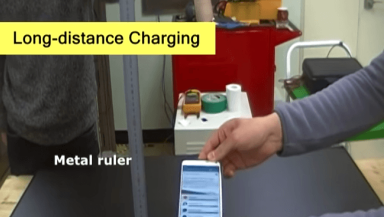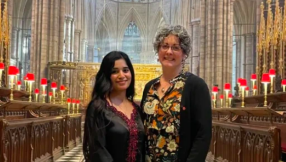
Recently, a research group at Korea Advanced Institute of Science and Technology (KAIST) came up with wireless power technology (WPT), which allows numerous mobile devices to charge up within a half meter radius of the charger.
Wireless charging has recently hit the consumer market and is making waves. However, the problem is that the current version of the technology still requires the device to be in close proximity of the charger. While charging, the device cannot be moved; even just adjusting the angle can be quite restricted. Aside from saving a few seconds from plugging the charger into the device, it offers no advantages at all from that of the wired one.
Professor Chun T. Rim and his team from the Nuclear and Quantum Engineering Department of KAIST addressed the close proximity and stationary issue by creating the WPT, which, as mentioned, allows multiple devices maintain their charging status, even if moved. It will continue charging as long as the device stays within the half-meter radius from the charger, which means that it can be positioned in any direction within the three-dimensional radial space.
According to an article from AsianScientist, the WPT at maximum load can simultaneously charge up to thirty mobile phones running at one watt each or five laptops at 2.4 watts each. The maximum power efficiency for the laptop is reported at only 34 percent.
To make the wireless charging possible, the team used high-frequency magnetic materials in a dipole coil structure in order to build a flat and thin transmitter system known as the Tx system. "The dipole coil resonance system (DCRS) is composed of two transmitting and receiving magnetic dipole coils placed in parallel, with each coil having a ferrite core and connected with a resonant capacitor. The ferrite cores were designed to reduce the core volume by half, and their ability to transfer power is nearly unaffected by human bodies or surrounding metal objects, making DCRS ideal to transmit wireless power in emergency situations," the AsianScientist article specified.
In the current version of the DCRS, the two dipoles coils are crossed so that rotating magnetic fields can be generated, which embeds them in the Tx's flat platform. Hence, the devices can then receive power from every direction.
Rim's team along with KAIST and TESLA are currently conducting field studies that involve implementation of the DCRS in several locations such as cafes and offices. Below is a video demonstration of the WPT from KAIST.
<center>It should be noted that a similar innovation already exists in the United States. In fact, it was proposed and proven feasible by a team of theoretical physicists from Massachusetts Institute of Technology (MIT) about a decade ago. The team was able to power a light bulb that was approximately two meters from the source. The whole concept came to Dr. Marin Soljačić after three nights of him waking up to his wife's mobile phone beeping for it was running out of power. Dr. Soljačić was named as MacArthur fellow and was awarded a MacArthur Genius Grant.
In 2007, the same team founded a Boston-based company called WiTricity. The company has made several significant advances in wireless power transfer. WiTricity is currently working with the military and companies from the automotive, industrial and medical sectors. Their technology gets embedded into the products of these companies. In fact, Toyota has recently licensed the inductive charging technology from WiTricity, specifically for its line of electric vehicles. Below is a 2009 video of Eric Giler's presentation for WiTricity as a guest of TedTalks.
<center>Of course, it would not be proper to talk about WPT without the mention of Nikola Tesla, one of the greatest minds of the past century. More than a hundred years ago, before anyone else, he was the first to submit a substantiated proposal for wireless energy transfer and proceeded to build the Wardenclyffe Tower to have his theory materialize.
The aforementioned innovations by KAIST and WiTricity are but a fraction of Tesla's vision of free and accessible energy for anyone at any point in the globe. People argue about the success of his Wardenclyffe project. Unfortunately, the FBI took down the tower due "security concerns" and his write-ups vanished right after his death. One thing's for certain though — Tesla, then a penniless 86-year-old man, died alone in his hotel room but what he started is now getting continued with more sophistication and a built-in meter.













